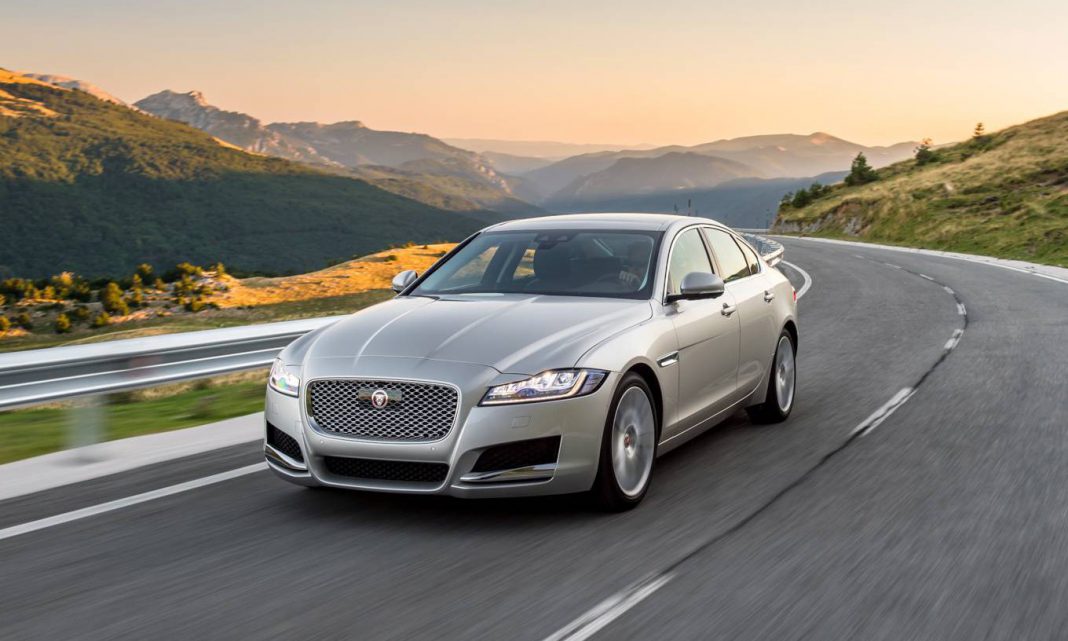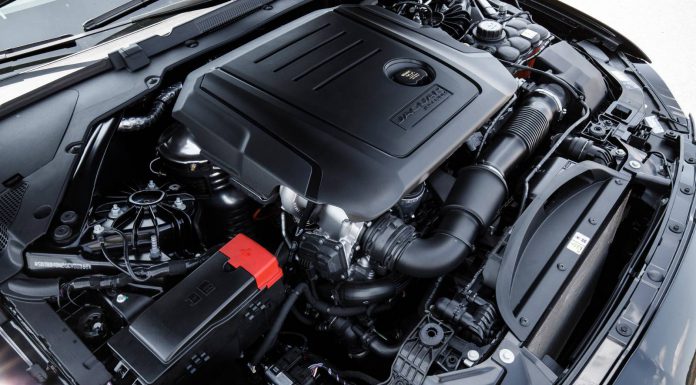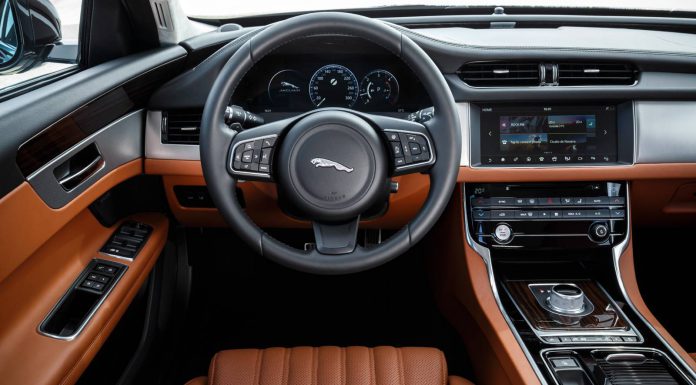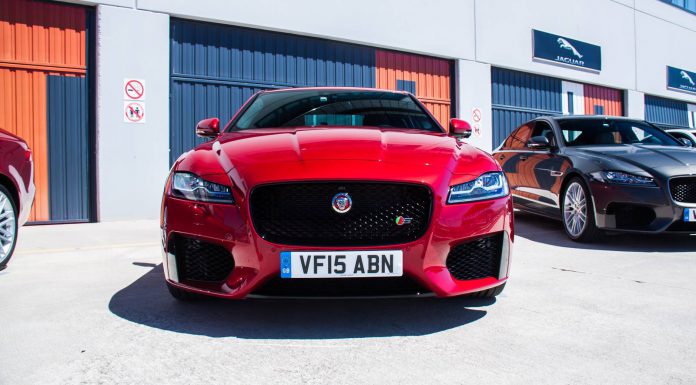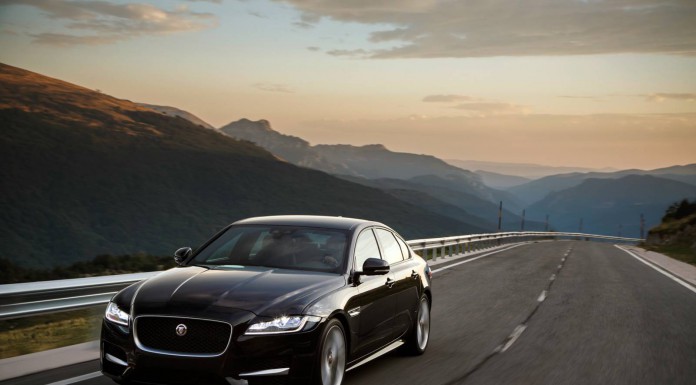Jaguar’s all new 2016 XF was first put into the spotlight at this year’s New York Auto Show. It is the second generation XF, replacing the first generation that was unveiled back in 2007. Being the best selling and most-awarded Jag since its first introduction, there is quite some weight on its shoulders to yet again push the cat train forward.
The new generation XF has a sleeker design, an assortment of powertrains, an updated infotainment system and underwent a significant weight reduction procedure by using aluminum for the body and chassis. The big question is: will it outperform the BMW 5-Series, Audi A6 and Mercedes-Benz E-Class? We headed out to Spain to find out.
Engine and Powertrain
The powertrain options range from the 2.0-litre 163 hp Ingenium diesel to the 3.0-litre 380 hp V6 petrol, which is featured in the XF-S, so far the most powerful type in the XF line-up. The entry-level four-cylinder Ingenium diesel model breathes the term efficiency which has been an obsession for both the XF engineering and design team.
The 75 per cent aluminium body and chassis resemble this as well, on which I will elaborate later. The efficient four-cylinder diesel is up to 80 kilograms lighter than its competitors in the same segment helping to improve fuel economy. Jaguar states that the CO2 emissions are just 104 g/km and that the car is capable of reaching 70.6 miles on the gallon, making it almost 20 per cent more efficient than its predecessor and making it the most efficient four-cylinder in the business segment.
Let’s move on to the 380 hp Supercharged 3.0-litre V6 XF-S, by far the most exciting XF in the line-up. The all-aluminium engine is identical to the one that is home to the F-Type, and the XF S is the first and only Jaguar saloon to feature it. The XF S is equipped with a ZF eight-speed automatic transmission and sprints to a 100 km/h in just 5.1 seconds. Like its German competitors, the top speed of the XF S is electronically limited at 250 km/h. These are quite impressive figures for this spicy business saloon.
There is a range of new driving enhancing technologies available on the new XF models as well. Jaguar configurable dynamics technology, which was first introduced on the F-type, is optional on all V6 models. This technology enables the driver to play around with the settings of the dampers, engine, steering and transmission. It is especially useful for those that do not find the standard dynamics mode satisfactory.
Another technology worth mentioning is the all-surface progress control available for automatic transmission featured models only. It automatically controls the throttle and brakes and is capable of pulling away smoothly from a variety of surfaces, getting the best traction possible. The speed of this procedure is limited at 30 km/h and can be altered by using the cruise control switches.
Chassis and Structure
Following a 400+ million pound investment at the Castle Bromwich Assembly Plant, Jaguar set its focus on using aluminium as the primary component of the body structure and chassis. The use of aluminium has several advantages. For starters, the 2016 XF is up to 190 kilograms lighter than its predecessor, which significantly contributes to the improved fuel economy and handling of the car. The aluminium bodywork also improves the stiffness of the car and its crash performance.
The torque vectoring by braking technology that we know from the F-Type, comes standard with every 2016 XF. It helps control understeer by applying controlled braking on the inside rear wheels, bringing it closer to the apex.
Another point I would like to mention is the electric power-assisted steering that the XF is known for. The steering is very direct and smooth, contributing to the agility of the car. The EPAS also features well working filters that neutralise sudden steering reactions as a result of inconsistencies you may find on the road ahead of you. Having it tested first hand and all things considered, there is no doubt that the Jaguar EPAS sets the benchmark in its class.
Design
In terms of design, the car has improved quite a bit. The much sleeker design that I mentioned earlier actually reflects the 190 kilograms weight loss. The main point of attention is the distinctive shoulder line that runs alongside almost the complete length of the car giving it a sleeker appearance. In general, the 2016 XF is made 7 mm shorter, but offers more leg (+15 mm), knee (+24 mm) and headroom (+27 mm) in the rear of the car by lengthening the wheelbase by 51 mm.
This not only provides the rear seat passengers with more comfort but it also contributes to the aerodynamics of the car. At the front of the car we find Jaguar’s signature grill that has been placed slightly more vertical in comparison to its predecessor, again to improve aerodynamics. The front is complimented by the recognizable J-shaped LED lights with all new adaptive LED technology, giving it the slightly aggressive look that most of us like to see when it pops up in your rear view mirror.
Arriving at the rear of the car, we can see the wide taillights with integrated LED technology that much look like the taillights of the Jaguar XE. The rear does not look as bulky as its predecessor and in my opinion has just the right proportions. The four-cylinder versions have a double-pipe sports exhaust on the left, whereas the V6 models have two distinctive pipes situated at the rear-center of the car, indicating that it has some more power under the hood.
Do not mistake the R-Sport – I guess the name does it – for the most powerful model in the line-up. It may look almost identical to the V6 S model but has nowhere near as much power. I am personally not a fan of styling cars in a way leading the public to believe that there is more to it than there actually is, but the British market in recent years has shown that there is a preference for the sporty look on cars that feature average engines in terms of capabilities and power.
Interior
Jaguar has a standard to live up to when it comes to the interior. The first thing you notice when pushing the start button of the car are the vents that spin open and the automatic transmission knob that pops up out of the center console. This really gives the driver that ‘sense of theater’, as Jaguar’s director of design, Ian Callum, puts it. I have to say that it does add to that feeling of driving a Jaguar.
The centre of attention is the all-new infotainment board computer with a 10.2-inch Incontrol Pro touchscreen. Whether a touchscreen works in a car has everything to do with how user-friendly it is and of course, its responsiveness. The position of the touchscreen may be – depending on your seating position and body length – a bit hard to reach, which can get annoying at times. The responsiveness of the touchscreen however, was great and it did not get stuck in any apps we were using while driving.
The only thing I could not get my head around, is that when you develop a large, well-working touchscreen and board computer that could potentially control everything electrical from climate control to side-view mirrors there is the need for so many buttons in both the mid-console and doors; less is more!
The infotainment system by itself seems to be well interconnected and let’s you connect up to eight devices at the same time. It shares its connection with your smartphone and other gadgets extensively, making it possible to turn the engine on or off with a simple touch on your smartphone. In addition to that, it let’s you control the climate control of the car from a distance, making sure the temperature inside the car is bearable before you get behind the wheel.
The infotainment system comes with its own developed apps, helping you get the most out of your Jaguar. It is connected with the Internet and offers its own music library at your disposal. The navigation is not something that particularly impressed me, although there are very few that actually do. Also bear in mind that we were provided with a beta version so there is some room for improvement.
Driving through tunnels the system showed some hiccups and all around I felt like green arrows on yellow marked roads is not the best colour combination one can think of. The optional heads-up display however, does make up for some of the imperfections in the beta version of the navigation system. It is large and colourful and perfectly readable in different lighting conditions.
Driving Experience
Arriving in sunny Northern Spain, the region of Navarra to be precise, we found ourselves a line-up of Jaguars right outside the airport of Pamplona. After a brief presentation, it was time to get on to the road with the 2016 Jaguar XF 2.0D. The 180 hp 2.0-litre diesel complimented with the R sport package is a perfectly capable business saloon for people that like a sporty appearance.
On the way down through the Spanish countryside, you could see the wooden fences alongside some of the roads. They are presumably there for the annual bull-runs, which the region is world famous for. This day however, the bulls cleared the roads for some mean looking Jaguars, a sight that turned quite a few heads in each town we passed through.
Having arrived at Circuito de Navarra, I quickly came to realize that the 2.0D was just an appetizer. It was time for the real deal, the 2016 XF S 3.0 V6 AWD. After a few more technical and design presentations it was time to strap my helmet on. The first thing you notice as other cars rush by is the howling supercharged turbo sound, which sounds very nice. After a few instructions, it was time to really put this big cat to the test. I immediately noticed how easy to handle and agile the car was, thanks to both the weight-loss and configurable dynamics technology. I should not forget to yet again address the top-notch Jaguar EPAS technology. It is absolutely fabulous and I dare to say that it literally ‘outsteers’ its German competitors by many turns.
With the traction control and torque vectoring by braking engaged, it is amazing how much grip this car has on the track. Steering into a corner you notice the torque vectoring by braking being put to work, correcting your otherwise imminent understeering maneuver. Once heading out of the last turn, there is a short straight on which you notice the quick throttle response and smooth transmission up to a 180+ km/h before heading into the first turn again. In addition to the aiding technologies the car features, you notice the stability that the stiff aluminium body and chassis bring you.
Following the track oriented activities; we got to drive the RWD version of the V6 petrol on some alpine roads. This was quite the difference compared to the 2.0D we drove earlier that day. The difference between the passive damping featured on the 2.0D and the dynamic damping on the V6 are obvious, just like the difference in power. The many hairpins and tight corners were no match for the V6 and its handling capabilities.
The second day we drove the XF 3.0D Portfolio, which is by all means no lightweight. After warming up it really showed its teeth as soon as you put your foot down. The 3.0 diesel offers 700 Nm of torque and 300 hp, but did not feel as stiff as the XF S. This sporty diesel was actually very comfortable to drive, more so than any other XF model I have driven.
This combination of power and comfort is probably the most desirable when driving the XF daily, getting you to Autobahn desired speeds in no-time. It effortlessly brought us to the summit of the Roncalia mountain in the Pyrenees without compromising with the sportive driving. Its playfulness should also be noted; sliding the rear in a hairpin is easily accomplished in sports mode.
Conclusion
Both the XF S and the XF 3.0D Portfolio, on which this review is mostly focused, are very capable cars in the business segment. The most awarded Jaguar ever, will surely form fierce competition against the 5-Series, E-Class and A6 and it would not surprise me if it would take a big chunk out of the German market share; in Britain, that is. The car is comfortable to drive and above all, Jaguar shows that it maintains its sports brand image by finding a great balance between luxury, comfort and power.
The new XF appeals to the eye and is equipped with the newest technologies. Accompanied by the great sounding house signature supercharged V6 – if you were to opt for the V6 S – it is a really entertaining car to drive too.

